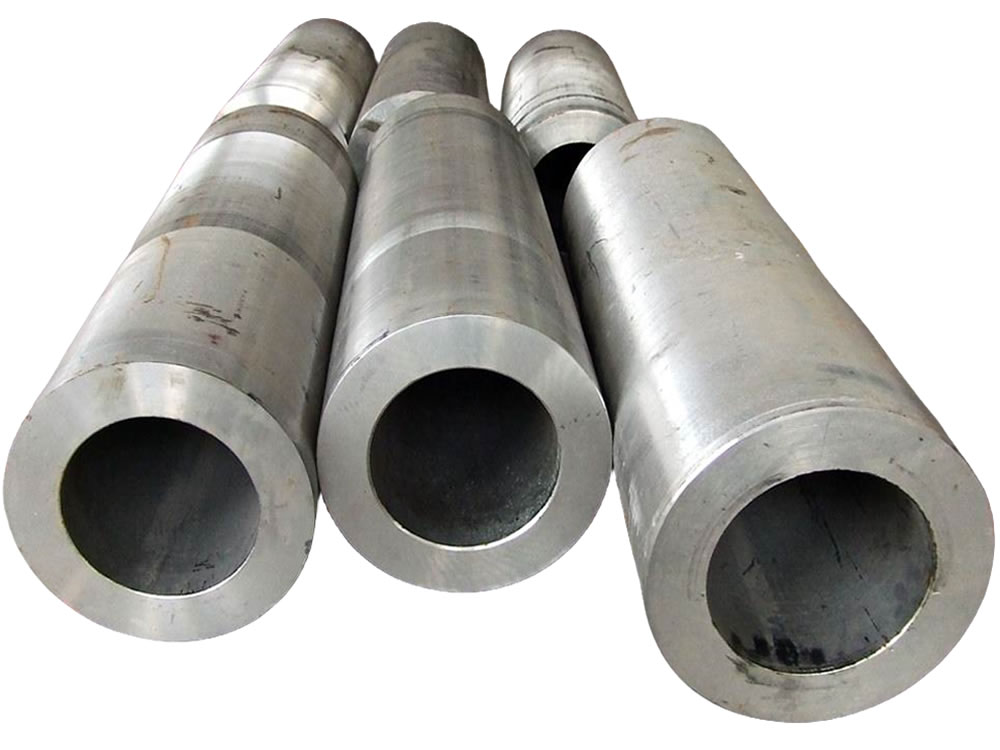Bearing Pipes
Pipes designed for bearing loads, offering high strength and durability.

Mechanical steel tubes are used in machined or formed parts of industrial, automotive, farm machinery, aircraft, transportation, materials handling, and household equipment.
Seamless mechanical tubing is furnished in both cold-drawn and hotfinished form in a wide range of sizes, from 1.375" to 7.750" OD and from 0.188" to 1.625" wall thickness, as shown on the chart to the right.
Mechanical tubes are used in automotive, industrial and precision engineering applications. Online OD and WT measurement during the production process enables United Seamless to deliver accurate dimensions throughout the length of the tube. We offer mechanical tubing from 4-1/2" to 14".
The tolerances for cold drawn seamless mechanical tubing can vary depending on the specific standards and requirements.
OD Size Range Inches,Inclusive |
WallPercent of OD |
OD Inches |
ID Inches |
Quenched&TemperedOD & ID ± Inches |
OD Size Range mm,Inclusive |
WallPercent of OD |
OD Inches |
ID Inches |
Quenched&TemperedOD & ID ± mm |
||||
|---|---|---|---|---|---|---|---|---|---|---|---|---|---|
Over |
Under |
Over |
Under |
Over |
Under |
Over |
Under |
||||||
0.500-1.699 1.700-2.099 2.100-2.499 |
All All All |
.005 .006 .007 |
.000 .000 .000 |
.000 .000 .000 |
.005 .006 .007 |
.015 .020 .023 |
12.70- 43.16 43.17- 53.32 53.33- 63.48 |
All All All |
0.13 0.15 0.18 |
0.00 0.00 0.00 |
0.00 0.00 0.00 |
0.13 0.15 0.18 |
0.38 0.51 0.58 |
2.500-2.899 2.900-3.299 3.300-3.699 3.700-4.099 |
All All All All |
.008 .009 .010 .011 |
.000 .000 .000 .000 |
.000 .000 .000 .000 |
.008 .009 .010 .011 |
.025 .028 .030 .033 |
63.49- 73.64 73.65- 83.80 83.81- 93.96 93.97-104.12 |
All All All All |
0.20 0.23 0.25 0.28 |
0.00 0.00 0.00 0.00 |
0.00 0.00 0.00 0.00 |
0.20 0.23 0.25 0.28 |
0.64 0.71 0.76 0.84 |
4.100-4.499 4.500-4.899 4.900-5.299 5.300-5.549 |
All All All All |
.012 .013 .014 .015 |
.000 .000 .000 .000 |
.000 .000 .000 .000 |
.012 .013 .014 .015 |
.036 .038 .041 .044 |
104.13-114.28 114.29-124.44 124.45-134.60 134.61-140.95 |
All All All All |
0.30 0.33 0.36 0.38 |
0.00 0.00 0.00 0.00 |
0.00 0.00 0.00 0.00 |
0.30 0.33 0.36 0.38 |
0.91 0.97 1.04 1.12 |
5.550-5.999 |
Under 6 6 to 71/2Over 71/2 |
.010 .009 .018 |
.010 .009 .000 |
.010 .009 .009 |
.010 .009 .009 |
.047 .047 .047 |
140.96-152.38 |
Under 6 6 to 71/2Over 71/2 |
0.25 0.23 0.46 |
0.25 0.23 0.00 |
0.25 0.23 0.23 |
0.25 0.23 0.23 |
1.19 1.19 1.19 |
6.000-6.499 |
Under 6 6 to 71/2Over 71/2 |
.013 .010 .020 |
.013 .010 .000 |
.013 .010 .010 |
.013 .010 .010 |
.050 .050 .050 |
152.39-165.08 |
Under 6 6 to 71/2Over 71/2 |
0.33 0.25 0.51 |
0.33 0.25 0.00 |
0.33 0.25 0.25 |
0.33 0.25 0.25 |
1.27 1.27 1.27 |
6.500-6.999 |
Under 6 6 to 71/2Over 71/2 |
.015 .012 .023 |
.015 .012 .000 |
.015 .012 .012 |
.015 .012 .012 |
.057 .053 .053 |
165.09-177.78 |
Under 6 6 to 71/2Over 71/2 |
0.38 0.30 0.58 |
0.38 0.30 0.00 |
0.38 0.30 0.30 |
0.38 0.36 0.30 |
1.45 1.35 1.35 |
7.000-7.499 |
Under 6 6 to 71/2Over 71/2 |
.018 .013 .026 |
.018 .013 .000 |
.018 .013 .013 |
.018 .013 .013 |
.065 .056 .056 |
177.79-190.48 |
Under 6 6 to 71/2Over 71/2 |
0.46 0.33 0.66 |
0.46 0.33 0.00 |
0.46 0.33 0.33 |
0.46 0.33 0.33 |
1.65 1.42 1.42 |
7.500-8.000 |
Under 6 6 to 71/2Over 71/2 |
.020 .015 .030 |
.020 .015 .000 |
.020 .015 .015 |
.020 .015 .015 |
.070 .060 .060 |
190.49-203.20 |
Under 6 6 to 71/2Over 71/2 |
0.51 0.38 0.76 |
0.51 0.38 0.00 |
0.51 0.38 0.38 |
0.51 0.38 0.38 |
1.78 1.52 1.52 |
| Wall ThicknessPercent of OD | Maximum Percent Over & Under Nominal | Wall ThicknessPercent of OD | Maximum Percent Over & Under Nominal | ||
|---|---|---|---|---|---|
| Under 1.499” ID | 1.500” ID & Over | Under 38.07mm ID | 38.07mm ID & Over | ||
| Under 10 | 10.0 | 7.5 | Under 10 | 10.0 | 7.5 |
| 10 to 25 | 10.0 | 6.0 | 10 to 25 | 10.0 | 6.0 |
| Over 25 | 12.5 | 7.5 | Over 25 | 12.5 | 7.5 |
Mechanical tubes are used for mechanical and light gauge structural applications.
Mechanical tubes are produced to meet specific end use requirements, specifications, tolerances and chemistries.
Tubing used for mechanical and light gauge structural applications. This allows for more specific property uniformity throughout the tube compared to standard pipe or tube. While Mechanical tube can be produced to standard specifications when requested, it is often produced to “typical” properties that focus mainly on the yield strength for a precise size and wall thickness. In some applications with severe forming, yield strength may not even be specified and the mechanical tube is produced to be “fit for use”. Mechanical tubing encompasses a wide range of both structural and non-structural applications.
At SunnySteel, we apply our metallurgical and production expertise to manufacture high-performance seamless mechanical tube products to meet your needs.
This includes carbon, alloy and even custom steel grades; annealed, normalized and tempered; stress relieved and stress free; and quench and tempered.
Seamless Steel Tubes for Mechanical and Automobile usage for Backbone of Automobile and rear axle tube, manufacturing and processing of precision equipments, instruments and apparatus.
Sunny Steel supply a 1/2 million foot inventory of carbon steel pressure tubing including boiler tubes, condenser tubes and heat exchanger tubes all made in the China.
Our carbon steel pressure tubing inventory is manufactured in accordance with ASME SA-178 A and/or ASME SA-214 in diameters of 3/4″ through 4”.
Backbone of Automobile and rear axle tube
Manufacturing and processing of precision equipments, instruments and apparatus
Delivery Condition: GBK, BKS, BK, BKW, NBK
Chemical Composition, Mechanical Properties, Visual and Dimension Test, NDT, Grain Size Test
Oil-dip, Varnish, Shot Blasting
Tubular products seamless mechanical tubing is furnished in both cold-drawn and hot finished form in a wide range of sizes, from 1.375″ to 7.750″ OD and from 0.188″ to 1.625″ wall thickness.
Tubular Products special seamless tubing configurations start with the highest quality steels. Grade, chemical analysis and surface condition are carefully considered, and production processes are tailored to achieve the best tubing for the end use.
The configurations are formed from round tube by cold drawing. The tube is drawn over a shaped mandrel or through a shaped die, or both. Improved tolerances, finishes and mechanical properties result.
Seamless and welded tubes for mechanical and general engineering applications. Tubes for construction and structural purposes such as civil structures, foundations, etc.
| Abbr. | Corresponding | Application |
|---|---|---|
| A511 | ASTM A511 / A511M | Specification for Seamless Stainless Steel Mechanical Tubing |
| A512 | ASTM A512 / ASME SA512 | Specification for Cold-Drawn Buttweld Carbon Steel Mechanical Tubing |
| A513 | ASTM A513 / A513M | Specification for Electric-Resistance-Welded Carbon and Alloy Steel Mechanical Tubing |
| A519 | ASTM A519 / A519M | Specification for Seamless Carbon and Alloy Steel Mechanical Tubing |
| A554 | ASTM A554 | Specification for Welded Stainless Steel Mechanical Tubing |
In the world of tubing, things can get a bit confusing. With many different types of tubing for different applications, terms and meanings can be a bit ambiguous. With this in mind, we’ve set out to explain the difference between structural tubing and mechanical tubing.
tubing used for mechanical and light gauge structural applications. Mechanical tube is produced to meet specific end use requirements, specifications, tolerances and chemistries. This allows for more specific property uniformity throughout the tube compared to standard pipe. While Mechanical tube can be produced to standard specifications when requested, it is often produced to “typical” properties that focus mainly on the yield strength for a particular size and wall thickness. In some applications with severe forming, yield strength may not even be specified and the Mechanical tube is produced to be “fit for use”.
tubing used for structural applications. Standard strength requirements of the tube help dictate applications for which certain tubing is most appropriate. Structural tube is often referred to as hollow structural sections or HSS.
Mechanical tubing encompasses a wide range of both structural and non-structural applications.
At Wheatland Tube, our mechanical tubing is manufactured to typical Mechanical tube properties or in accordance with ASTM A500 and A513 Types 1 and 2 specifications.
Our Mechanical tubing is not limited to these specifications and can be produced to specific customer requirements when appropriate.
Additionally, our in-line galvanized products comply with A1057 and A787 coating specifications and provide a synergistic triple-coat process for enhanced product life.
While specifications will vary based on design (and from manufacturer to manufacturer), some common specifications of structural tubing include ASTM A500 Grade B and C, A847, A1065, and the recently approved ASTM A1085.
In both cases of “Structural” or “Mechanical” tubing, these products are ordered to a specific outside dimension (OD) and “gauge” or wall thickness. This varies from “pipe” products which are ordered based on inside dimensions (ID) and often pipe “schedules” that determine the wall thickness. Pipe and conduit products should not be used in structural applications as their strength properties may not be produced to standard structural specifications or meet specified engineering requirements.

When you partner with Sunny Steel, you can stop worrying about meeting deadlines thanks to our responsive and timely service. You'll also say goodbye to unnecessary shopping around. Instead, you'll get white glove service from an expert who understands your needs and can get you the materials you need quickly.
